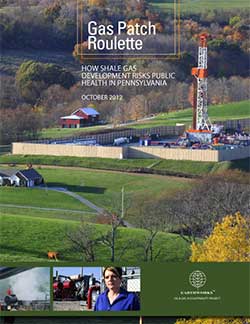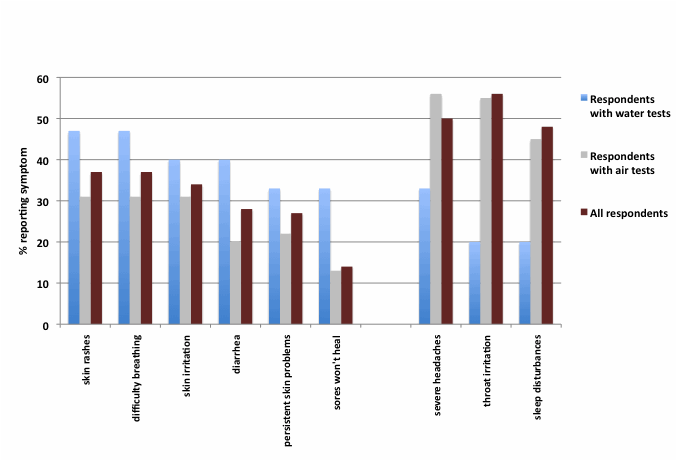Gas Patch Roulette: Differences in symptoms based on respondents with air and water tests

NOTE:This additional documentation is in support of the report Gas Patch Roulette: How Shale Gas Development Risks Public Health in Pennsylvania
Exposures to chemicals and pollutants related to oil and gas development may come from multiple sources (e.g., contamination of water sources from leaking waste impoundment pits and tanks or spills of chemicals or wastewater; air emissions from pits, tanks, compressors, wellheads and other oil and gas infrastructure, spills of chemicals or wastes, etc.).
Many survey respondents indicated that they had concerns about contamination of their drinking water and/or exposure to air emissions from nearby gas development. (Note: The survey did not specifically ask about water concerns, but some survey respondents offered that information. Additionally, some respondents conveyed that information to Earthworks through interviews or initial discussion related to the survey.)
Figure 4.
Symptoms from respondents with water & air tests

Click chart thumbnail for larger view
Earthworks conducted water and air tests at some of the homes of survey respondents. There were 15 survey respondents who had water tested at their homes, and there were 55 respondents who had air tests conducted at their homes.
It is interesting to note, as seen in the chart, that a higher percentage of those who perceived that they had problems with water reported symptoms such as diarrhea and skin issues – symptoms that may be associated to ingesting or bathing in water that contains contaminants. Those who perceived that air exposure to gas-related contaminants was a primary concern more often reported severe headaches and throat irritation, which may be associated with breathing in air contaminants.

The results were complicated by the fact that some of the people receiving water tests also expressed concerns about air exposures (46% reported smelling odors that they associated with gas development), and 43% of those receiving air tests also had water concerns. Therefore, the following analysis does not prove that those receiving water tests had symptoms caused by contaminated water, or that they did not have symptoms related to air exposures. Nor does it prove that those receiving air tests had symptoms solely related to air exposures.
The results, however, do suggest that this is an area that bears further scrutiny and research.
For more information:
- Gas Patch Roulette: Summary Report
- Gas Patch Roulette: Full Report
- All available information associated with the report, including support documentation not in the full report.
- ShaleTest: www.shaletest.org
- Understanding your Water and Air Tests
Tagged with: toxics, regulation, public health, pennsylvania, marcellus shale, health and toxics, gas patch roulette, fracking
Follow Earthworks